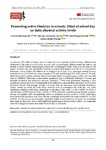Mostrar o rexistro simple do ítem
Promoting Active Lifestyles in Schools. Effect of School Day on Daily Physical Activity Levels
| dc.contributor.author | Varela Garrote, Lara | |
| dc.contributor.author | Carretero, Miriam | |
| dc.contributor.author | Fraguela-Vale, Raúl | |
| dc.contributor.author | Losada-Puente, Luisa | |
| dc.date.accessioned | 2022-09-06T11:08:31Z | |
| dc.date.available | 2022-09-06T11:08:31Z | |
| dc.date.issued | 2022 | |
| dc.identifier.citation | Varela-Garrote L, Carretero-García M, Fraguela-Vale R, Losada-Puente L. Promoting active lifestyles in schools. Effect of school day on daily physical activity levels. Phys Act Rev 2022; 10(1): 130-140. doi: 10.16926/par.2022.10.14 | es_ES |
| dc.identifier.uri | http://hdl.handle.net/2183/31514 | |
| dc.description.abstract | [Abstract] Introduction: The effect of school day is a major factor in everyday rhythms during childhood and adolescence. The relevance of Physical Activity (PA) in school-aged children raises the need to: (a) analyse whether Primary School pupils achieve the recommended levels of daily PA; (b) find out the impact of school day and, specifically, Physical Education (PE) classes on levels of PA compared to weekends; and (c) explore the differences according to sex in daily PA at these ages. Method: A cross-sectional study was carried out, using a sample of 126 participants (aged 10.2±0.48 years; 51.6% girls, 48.4% boys) from primary schools. Data on the steps taken by pupils during a week were recorded with an ADXK362 three-axis accelerometer integrated into a wristband. Descriptive (means and standard deviation) and inferential analyses (Student’s T-Test) were performed, assuming a 95% confidence interval (p<0.05). The magnitude of the difference was quantified with power (1-β), α=0.05 (bilateral). Results: The average of steps was lower than the minimum recommended, revealing a weekly pattern in which, the most active children were so throughout the week and vice versa. Significant variations were found depending on the days of the week (r=0.40, p<0.001, d= 0.63) or whether they had PE classes (r=0.65, p<0.001, d= 0.79). School day contributed significantly to greater activity and families were less physically active on weekends (t=6.62, p<0.001, d=0.70). Girls had a lower level of PA than boys, and more difficulty reaching the recommended levels of daily PA (t=-4.05, p<0.001, d=0.96), except on weekends. Conclusion: Pupils do not reach the minimum recommended daily steps for their age, with a well-established gender gap in favour of boys. School day (especially when PE is taught) increases their daily PA more than at weekends. | es_ES |
| dc.language.iso | eng | es_ES |
| dc.relation.uri | https://doi.org/10.16926/par.2022.10.14 | es_ES |
| dc.rights | Atribución 4.0 Internacional | es_ES |
| dc.rights.uri | http://creativecommons.org/licenses/by/4.0/ | * |
| dc.subject | Primary education | es_ES |
| dc.subject | School time | es_ES |
| dc.subject | Physical education | es_ES |
| dc.subject | Health education | es_ES |
| dc.subject | Gender roles | es_ES |
| dc.title | Promoting Active Lifestyles in Schools. Effect of School Day on Daily Physical Activity Levels | es_ES |
| dc.type | info:eu-repo/semantics/article | es_ES |
| dc.rights.access | info:eu-repo/semantics/openAccess | es_ES |
| UDC.journalTitle | Physical Activity Review | es_ES |
| UDC.volume | 10 | es_ES |
| UDC.issue | 1 | es_ES |
| UDC.startPage | 130 | es_ES |
| UDC.endPage | 140 | es_ES |
| dc.identifier.doi | 10.16926/par.2022.10.14 |
Ficheiros no ítem
Este ítem aparece na(s) seguinte(s) colección(s)
-
GI-EUNOIA - Artigos [20]






